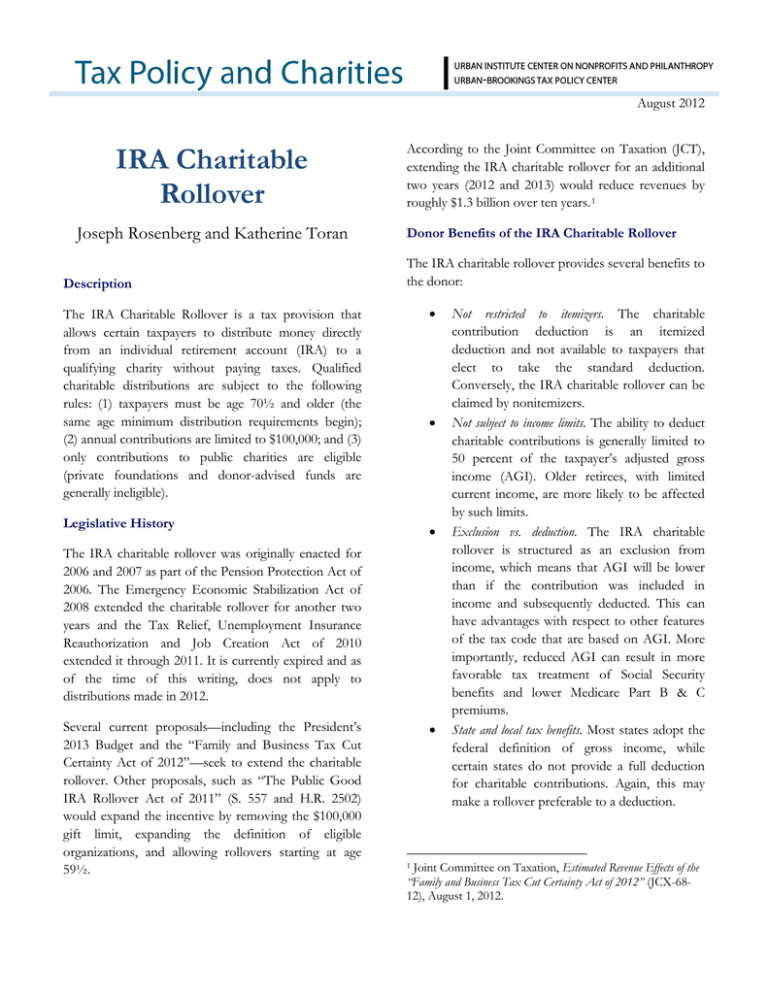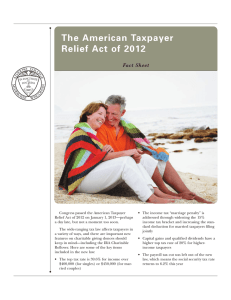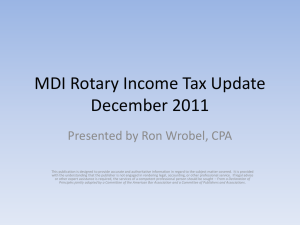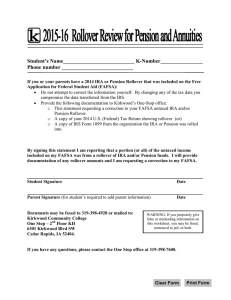IRA Charitable
advertisement

August 2012 IRA Charitable Rollover Joseph Rosenberg and Katherine Toran Description According to the Joint Committee on Taxation (JCT), extending the IRA charitable rollover for an additional two years (2012 and 2013) would reduce revenues by roughly $1.3 billion over ten years. 1 Donor Benefits of the IRA Charitable Rollover The IRA charitable rollover provides several benefits to the donor: • The IRA Charitable Rollover is a tax provision that allows certain taxpayers to distribute money directly from an individual retirement account (IRA) to a qualifying charity without paying taxes. Qualified charitable distributions are subject to the following rules: (1) taxpayers must be age 70½ and older (the same age minimum distribution requirements begin); (2) annual contributions are limited to $100,000; and (3) only contributions to public charities are eligible (private foundations and donor-advised funds are generally ineligible). • Legislative History • The IRA charitable rollover was originally enacted for 2006 and 2007 as part of the Pension Protection Act of 2006. The Emergency Economic Stabilization Act of 2008 extended the charitable rollover for another two years and the Tax Relief, Unemployment Insurance Reauthorization and Job Creation Act of 2010 extended it through 2011. It is currently expired and as of the time of this writing, does not apply to distributions made in 2012. Several current proposals—including the President’s 2013 Budget and the “Family and Business Tax Cut Certainty Act of 2012”—seek to extend the charitable rollover. Other proposals, such as “The Public Good IRA Rollover Act of 2011” (S. 557 and H.R. 2502) would expand the incentive by removing the $100,000 gift limit, expanding the definition of eligible organizations, and allowing rollovers starting at age 59½. • Not restricted to itemizers. The charitable contribution deduction is an itemized deduction and not available to taxpayers that elect to take the standard deduction. Conversely, the IRA charitable rollover can be claimed by nonitemizers. Not subject to income limits. The ability to deduct charitable contributions is generally limited to 50 percent of the taxpayer’s adjusted gross income (AGI). Older retirees, with limited current income, are more likely to be affected by such limits. Exclusion vs. deduction. The IRA charitable rollover is structured as an exclusion from income, which means that AGI will be lower than if the contribution was included in income and subsequently deducted. This can have advantages with respect to other features of the tax code that are based on AGI. More importantly, reduced AGI can result in more favorable tax treatment of Social Security benefits and lower Medicare Part B & C premiums. State and local tax benefits. Most states adopt the federal definition of gross income, while certain states do not provide a full deduction for charitable contributions. Again, this may make a rollover preferable to a deduction. Joint Committee on Taxation, Estimated Revenue Effects of the “Family and Business Tax Cut Certainty Act of 2012” (JCX-6812), August 1, 2012. 1 • Satisfies minimum distribution Taxpayers age 70½ and older are make annual distributions from would otherwise be included income. requirements. required to IRAs that in taxable Discussion The principal rationale for the IRA charitable rollover is to encourage charitable giving by providing an alternative, more generous, tax incentive for those who are required to make distributions from their IRAs. A large body of economic research has found that the presence of tax incentives increase charitable giving, although the size and nature of the increase is subject to debate. Another rationale is that the IRA rollover provision may simplify giving, as when a mutual fund offers taxpayers the option of contributing out of their IRA accounts from which withdrawals are already being made. The IRA charitable rollover allows certain taxpayers to avoid limits on the existing charitable deduction— including the restriction of the deduction to itemizers, the income limitation on charitable deductions (generally 50 percent of AGI), and the overall limit on itemized deductions. The increased incentives are therefore more likely to affect older taxpayers that would not otherwise itemize deductions and would not benefit from the current deduction. In addition, income-based limits on the amount of deductible charitable contributions might disproportionately impact older individuals, who are likely to have low current income relative to their ability to donate. These taxpayers tend to have higher wealth relative to income from which they might donate. No publicly available data currently exists to assess the amount of qualified charitable distributions or, more importantly, evaluate the extent to which the IRA charitable rollover provision has impacted overall giving. Since its inception in 2006, the IRA charitable rollover has been included in a large group of temporary provisions—commonly referred to as a “tax extenders.” Uncertainty surrounding whether or not this provision will be extended complicates planning efforts and, when applied retroactively, almost certainly reduces the efficacy of the incentive. Survey Evidence: IRA Charitable Rollover In 2008, the National Committee on Planned Giving (NCPG) conducted an informal survey asking charitable organizations to report qualified IRA distributions. Approximately 900 charities (mostly institutions of higher education) reported nearly 8,700 such distributions. Donations of less than $5,000 accounted for nearly 60 percent of all distributions, although they represented only 6 percent of the total dollar value reported. Donations in excess of $25,000 accounted for less than 20 percent of donations, but nearly 75 percent of the total dollar amount. Source: “National Committee on Planned Giving Survey of IRA Distributions to Charity.” Partnership for Planned Philanthropic Giving. March 24, 2008. http://www.pppnet.org/pdf/NCPG-IRA-survey-general-results-(3-24-08).pdf. Issue Brief Number 1: Tax Policy and Charities Project This brief is based on research funded in part by the Bill & Melinda Gates and the Charles Stewart Mott Foundation. The findings and conclusions contained within are those of the authors and do not necessarily reflect positions or policies of either Foundation. This publication is part of the Urban Institute’s Tax Policy and Charities project. The purpose of this project is to analyze the many interactions between the tax system and the charitable sector, with special emphasis on the ongoing fiscal debates at both the federal and state levels. For further information and related publications, see our web site at http://www.urban.org/taxandcharities/index.cfm.





